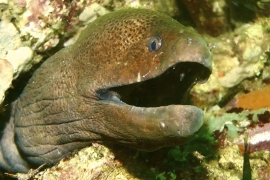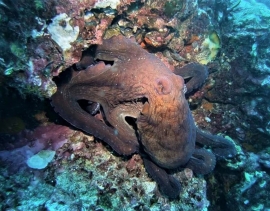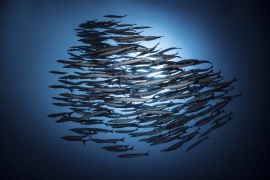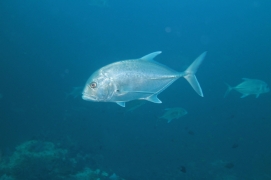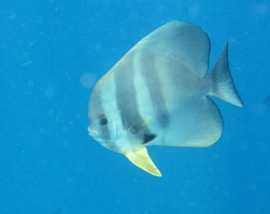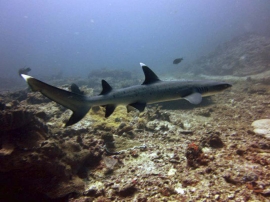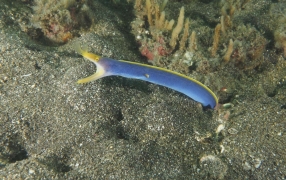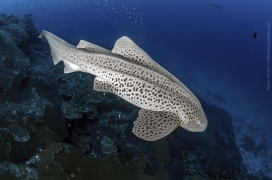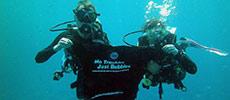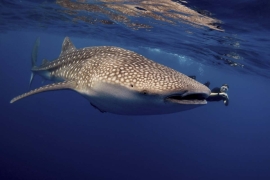
Baa Atoll Liveaboard Diving
Baa Atoll is surely among the best places to dive in The Maldives. Not only is it famous for the Manta Ray madness at Hanifaru Bay, it is also home to more than 60 dive sites in the area. Technically, Baa Atoll is just a name for the administrative area that actually covers three natural atolls, which are Southern Maalhosmadulu, Fasdhūtherē, & Goifulhafehendhu. In total, there are more than 70 islands in the area, nearly 60 of which are uninhabited. The remaining few are either resort islands or inhabited by locals offering budget travel facilities. The area is on the western side on The Maldives, in what's referred to as the northern atolls. However, it's the southernmost atoll of this 'northern atoll' region, so it's effectively a north-central atoll.

Although Baa Atoll is most famous for the world's largest congregation of Manta Rays at Hanifaru Bay there are more than 60 dive sites in the atoll.
And anyway, divers can't dive at Hanifaru Bay anymore. It's only available to a limited number of snorkellers at a time. In the past, fishermen used to use the bay to catch Whale Sharks, which was soon banned. Then along came scuba divers, with their numbers increasing every season. Soon enough the numbers of the Manta Rays and Whale Sharks reduced, so the Maldivian authorities took action. In 2011 it became a UNESCO World Biosphere Reserve. Now, there's a strict limit to the number of people who can enter at a time, and this is only snorkellers & freedivers. Scuba divers release bubbles, which could affect the rays' & sharks' behaviour. Anyway, all of the action is at the surface of shallow water, so there's no real need to dive. In addition to the restrictions of how many people can enter, everyone is watched closely by the local rangers, both from the water and using drones. Anyone who gets to close or touches the mantas or fires a camera flash is instantly dealt with.
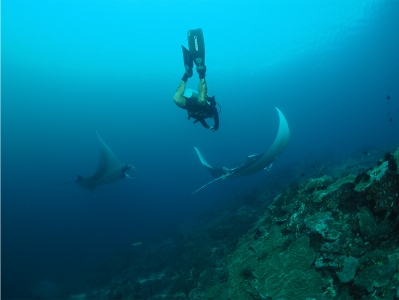 Manta Ray: Credit Johan FolmeusFrom May to November (but better from July to October) Manta Rays are attracted to this bay in huge numbers, sometimes more than 100 at a time. Due to the ocean currents, at high tide, the plankton is forced to the surface, but it attempts to stay deep. Thus it's concentrated near to the surface and becomes a plankton soup for these majestic filter-feeding giants. The plankton are trapped in the narrow bay which faces west on this uninhabited island. Dozens of Manta Rays form an orderly line swimming one in front of the other, sieving the microscopic creatures through their gills. And sometimes Whale Sharks join in the action, making for an amazing sight that you will never forget. The bay is also a popular nursery for the young of sharks & smaller rays. Don't worry if you're a diver on a Maldives liveaboard trip. On set days of the week, the authorities allow liveaboard guests to enter Hanifaru Bay, but only for snorkelling. This is normally organised to fit in with your liveaboard scuba diving cruise, between dives at nearby dive sites. Please note that the Manta Rays come from May to November, particularly June to October, but the 'high season' for the Maldives for the best weather and sea conditions is January to March. So, it's a compromise of the best snorkelling experience with dozens of Manta Rays compared to better weather and underwater visibility for your diving.
Manta Ray: Credit Johan FolmeusFrom May to November (but better from July to October) Manta Rays are attracted to this bay in huge numbers, sometimes more than 100 at a time. Due to the ocean currents, at high tide, the plankton is forced to the surface, but it attempts to stay deep. Thus it's concentrated near to the surface and becomes a plankton soup for these majestic filter-feeding giants. The plankton are trapped in the narrow bay which faces west on this uninhabited island. Dozens of Manta Rays form an orderly line swimming one in front of the other, sieving the microscopic creatures through their gills. And sometimes Whale Sharks join in the action, making for an amazing sight that you will never forget. The bay is also a popular nursery for the young of sharks & smaller rays. Don't worry if you're a diver on a Maldives liveaboard trip. On set days of the week, the authorities allow liveaboard guests to enter Hanifaru Bay, but only for snorkelling. This is normally organised to fit in with your liveaboard scuba diving cruise, between dives at nearby dive sites. Please note that the Manta Rays come from May to November, particularly June to October, but the 'high season' for the Maldives for the best weather and sea conditions is January to March. So, it's a compromise of the best snorkelling experience with dozens of Manta Rays compared to better weather and underwater visibility for your diving.
With often more than 100 Manta Rays within Baa Atoll at Hanifaru Bay, and the large congregations only happening at high tide for 2-3 hours, these gentle giants can easily be seen by divers at nearby dive sites. There are several 'cleaning stations' where the Manta Rays visit. There are more than 60 dive sites within Southern Maalhosmadulu Atoll, most of which are on the eastern side. The easternmost point of Southern Maalhosmadulu is facing Lhaviyani Atoll, and there are more than a dozen deep channels (kandus) on its south side, plus a similar amount to its north, and lots of thilas nearby. This all makes for plenty of healthy and diverse marine life. There's plenty of cool nutrient-rich water that passes through, but at the same time, there's lots of protection. This means that smaller and resident reef species can flourish, but also there's plenty of food for large pelagic visitors. Scuba divers can enjoy the benefits brought by the currents, but also hide in protected pockets if they want more of a relaxing dive.
Dive sites you can enjoy at Baa Atoll during your Maldives liveaboard diving safari.
Dhigali Haa & Thila
Dhigali Haa & Thila is one of the best dive spots at Baa Atoll. It is near the centre of the lagoon, further than others from Hanifaru Bay and the eastern kandus. It's not where you will likely encounter Manta Rays, but this long and narrow reef has lots of life all over it, and is a photographer's and macro lover's dream. It's covered in hard & soft corals and surrounded by marine life of all shapes & sizes.
Anga Faru / The Aquarium
Anga Faru / The Aquarium is on the southwestern periphery of the condensed dive sites which are on the eastern edge of Baa Atoll. Here you can see juvenile Grey Reef Sharks because it's a popular nursery for this species. There are plenty of resident species and schooling fish to look out for. Anga Thila is part of the faru, and is another great dive site with five pinnacles between 25 & 30 metres, for advanced divers only.
Nelivaru is a faru (mini atoll)
Nelivaru is a faru (mini atoll) with an uninhabited island and home to the southernmost dive sites of Southern Maalhosmadulu. It's one of the Manta Ray cleaning stations of Baa Atoll. And even when the Mantas don't come, it's a great dive site, with a reef that starts around 14m. and descends down to 30m. There are plenty of overhangs and caverns, surrounded by marine life. And even if there were no fish here, it is worth diving just to admire the magnificent topography of the reef.
Dhonfanu
Dhonfanu is an inhabited island in the heart of the action on the east side of the atoll. It's another popular Manta Ray cleaning station as well as having a popular swim through, but this is too deep for basic Open Water divers. Deeper down here you can expect to see Grey Reef Sharks and Eagle Rays. And at all depths, there are thousands of reef fish, plus schools of Barracuda and Jacks.
Dharavandhoo
Dharavandhoo is the largest Baa Atoll island and has the local airport. It is located in the southeast corner of the atoll. This area is suitable for all levels of diver and offers more protection from currents and surface waves. The area facing east to the outside of the atoll is a sloping sandy reef with plenty of life. On the inside, there are lots of attractive overhangs, covered by sea fans. Manta Rays often visit this reef to be cleaned.
Goifulhafehendhoo Atoll
Goifulhafehendhoo Atoll is a natural atoll 12km. south of Southern Maalhosmadulu, but still officially part of Baa Atoll. At its eastern tip is Goidhoo Island, which is home to a local community and some budget tourist facilities. And there are two more inhabited islands making the north reef. Manta Rays also visit this mini atoll, and there are several excellent dive sites. It's just far enough away from the main atoll to feel like another world because it's so quiet.
Other Baa Atoll dive sites, in alphabetical order, are as follows, and some may be duplicated due to their local and English names.
Conditions at Baa Atoll
When to dive at Baa Atoll
The best weather and sea conditions are from January to April, because in May the monsoons change and June & July are the wettest months. However, if you want to see as many Manta Rays as possible, you need to join a liveaboard cruise from July to October, which is when they congregate in Hanifaru Bay.
What type of dive site is Baa Atoll
Mainly coral reefs, including sandy slopes, underwater pinnacles, drop-offs, overhangs, swim-throughs, and drift dives.
Where is Baa Atoll?
Baa Atoll is the southernmost atoll of the northern atolls, on the west side of the country.
How to get to Baa Atoll
The best way to visit Baa Atoll is to fly into Male and join a Maldives liveaboard diving safari for 7 or 10 days, that will include several other atolls in the region.
Who can dive at Baa Atoll
All levels of certified scuba diver can enjoy diving at Baa Atoll, but some of the dive sites require Advanced certification and/or more than 50 logged dives' experience. It's usually possible to upgrade your diver certification onboard your liveaboard cruise.
What marine life can you see at Baa Atoll?
Most people come to Baa Atoll to see dozens of Manta Rays & maybe some Whale Sharks in the water at the same time in Hanifaru Bay. These are the big attractions from July to October. But throughout the year you can see all kinds of marine life, both big and small. Grey Reef Sharks & Eagle Rays are particularly common here, especially the juveniles which start their lives in Baa Atoll.
Summary of Baa Atoll
Baa Atoll is one of the best atolls for diving in The Maldives. In addition to the great choice and variety of dive sites, marine life is healthy, abundant & diverse. Many people come here to see sometimes more than 100 Manta Rays and even Whale Sharks all feeding together. This can be done in Hanifaru Bay from June to November. But only snorkelling is allowed in Hanifaru Bay, in strictly-controlled numbers.

